Travel Date: 2024/07/20
Just a few days before the arrival of Typhoon Gaemi, we took a trip to Lukang, Changhua. It's one of my favorite towns to visit because it's steeped in historical buildings, much like Tainan. One day isn't enough to see it all! We wandered through some narrow lanes and visited Lukang Old Street, which was bustling with activity. Along the old street, you can see many buildings from the Qing Dynasty. I love the architecture because it looks so different from what we see today. Although my all-time favorites are the buildings left from the Japanese occupation, many people dislike them, and I often get angry reactions when I post about them on Facebook. Well, it's part of Taiwan's history now, so why not cherish it? They look unique and attract many tourists. Taiwan has turned many Japanese relics into popular tourist areas, and Japan is the top country Taiwanese people travel to, so why hate on it?
Anyway, back to the topic. We spent the day discovering old places in Lukang. The weather was hot—very hot—as it reached at least 34 degrees Celsius, not to mention the actual heat when you walk in full sun.
Our first stop was Wenwu Temple, which we last visited about six years ago. Time flies so fast. Part of the temple was under renovation, but the area is quite large, so there were still plenty of places to visit, and the renovation didn't bother us at all. The temple has free parking, which made it convenient to stop by.
Later, we headed into town. On the way, we saw an old train station building that is now a care center. After equipping ourselves with some cold drinks and asking for food recommendations, we moved on. We tried one of the famous baozi shops, but I didn't enjoy it—the bun was like air, and there was barely any filling. Honestly, I couldn't taste any flavor. It's a tourist-famous shop, and from my experience, all tourist spots and popular shops are just expensive and not tasty—at least in my opinion.
While searching for Lukang Old Street, we passed through Jiuqu Lane. At the end, there was a market where we tried some noodles. Although my husband said the flavor was different from others, I liked it. Nearby, there was a popular shaved ice shop, but we were already full, so we skipped it and continued. We walked through Lukang Old Street, visited a paper art exhibition, and explored the Lukang History Museum, which is housed in an old Japanese-era dormitory. Scrolling through Google Maps, I noticed a Japanese shrine, so we went to check it out.
Walking through another small lane, we visited Heqi Villa, a house that belonged to a wealthy family during the Qing Dynasty. Something I had never seen before was a well inside a house. The shrine is actually next to it, and reading the reviews, it turns out to be an art installation set up in 2022.
Another place we visited was the Ding Family Mansion, which is really large—probably one of the largest houses we have ever seen. The area has a front entrance on Zhongshan Road, a busy place, but the entrance from the back is very empty and quiet. There's also a place to park at the back, so it's probably easier to start from there.
We ended our trip with a stop in Erlin, where we had never been before. We ate at a jīpái shop called HFC, which I highly recommend because the chicken was big and extra juicy. We also visited an elementary school to see several Japanese-era buildings. One of them reminded us of a building we saw at Jingliao Elementary School (you can check it out HERE).
That concluded our trip, which was really fun but tiring due to the heat.
Lukang Travel Part I [LINK]
Erlin Travel [LINK]
Lukang Old Street (鹿港老街)
Lukang Old Street primarily consists of Yaolin Street and Putou Street. During the Dutch and Qing Dynasty periods, Lukang was Taiwan's most important foreign business port and experienced significant commercial development.
In 1934, during the Japanese occupation, urban corrections in Lukang led to the widening of Tianlao Street (now Zhongshan Road), transforming the houses on both sides into modern concrete structures. However, Yaolin and Putou Old Streets still retain their traditional Lukang patterns and were designated as the Lukang Ancient Street Preservation Area in 1986.
Lukang Old Street spans over 500 meters and includes Yihexing, Xinzu Palace, Guihua Lane, and Lukang Public Hall. It preserves early storefront buildings and long-striped Fujian-style structures, showcasing architectural styles from the Qing Dynasty to early Taiwan history. Lukang boasts the second-highest number of historic sites in Taiwan, following Tainan.
Half-Sided Well (半邊井)
Banbianjing, located within the Wang family's residence, is a unique well with one side inside the house's wall and the other side outside. In the past, only wealthy families could afford wells, so they built these half-sided wells with one side for their family's use and the other for passers-by or less fortunate individuals to fetch water. Similar wells were also built between neighboring families. Today, with the prevalence of tap water, almost all half-sided wells are closed and unused.
Lukang Mazu Temple (鹿港天后宮)
Lukang Mazu Temple, one of Taiwan's oldest temples, boasts a history of nearly 400 years and is recognized as a National Historic Site. In 1591, flourishing trade between Lukang and coastal towns in mainland China prompted local residents to raise funds for constructing the Lukang Tianzhu Temple. The original temple ruins are in Sanjiao Lane on the north side of the site. In 1683, due to cramped space, the old temple was relocated to its current site for reconstruction, which was completed ten years later and named Shih-Zhen (later renamed Babaozhen). This completion attracted many immigrants to the Changhua Plain, transforming Lukang into a bustling town.
In 1725, the temple's increasing popularity led wealthy merchants like Shi Shibang to expand its land. By 1815, the reconstructed Tianhou Palace was completed. A major renovation occurred from 1923 to 1937. In 1974, a large archway was constructed in front of the temple square, and the four-story Shengen Building was preserved for pilgrims. In 1990, the Mazu Cultural Relics Museum was established, exhibiting the temple's historical artifacts. A new ten-story pilgrim building opened in 1998. On October 1, 2019, the temple was upgraded to a "National Site."
Lukang Ding Family Mansion (丁家古厝)
The Ding Family Mansion, also known as the Ding Family Old Residence, is a historic site on Zhongshan Road in Lukang. Dating back to the Guangxu period of the Qing Dynasty, this mansion showcases traditional Chinese architecture with shop fronts, deep wells, illuminated spaces, central wells, and a grand hall. Constructed using imported granite slabs and cedarwood, it stands as a testament to the Ding family's legacy and the evolution of Lukang over a century.
Originally established by Ding Shouquan, who achieved the rank of jinshi in the imperial examinations, the mansion was later expanded in 1893 by Ding Xieyuan to accommodate the growing family. During the Japanese colonial period, part of the mansion was demolished in 1934 for urban improvements, leading to the addition of a second-floor façade with terrazzo decoration and a Western-style appearance. Despite these changes, the mansion has retained its original layout and historical significance. It was restored in 2005 and is now a county-designated historical site open to visitors.
Key features include the Yang Building, constructed in 1919 in the Meiji style, and the Ku Feng Building, an 18th-century structure built in the Min-nan style. The mansion houses a collection of artifacts from the Ming and Qing dynasties, including vintage photographs, lacquerware, porcelain, carved stones, embroidery, and musical instruments.
Visitors can explore the well-preserved architecture and historical artifacts, gaining insight into the traditional lifestyle and architectural aesthetics of the Qing Dynasty. The Ding Family Mansion offers a fascinating journey through time in the heart of Lukang, making it a valuable destination for those interested in Taiwan's historical and cultural heritage.
Heqi Villa (鶴棲別墅)
Heqi Mansion, located in Houchu Lane, Lukang Township, is a mixed-style residence combining Minnan (Southern Fujian) and Western architectural elements. Originally built in the late Qing Dynasty, it has undergone multiple renovations to achieve its current form. On February 17, 2018, it was converted into the Suburban Museum, and in August 2019, it was officially named the Craft Exhibition Hall, showcasing outstanding local crafts.
The House complex includes several buildings. The main residence of Wang Huang was constructed in the late Qing Dynasty, with the first entrance hall built during the Japanese colonial period. The house was once the business location for Wang Huang's financial trust operations under the trade name "San Tai Hang" with mainland China. The main hall features calligraphy and paintings by Lukang scholar Zheng Hongyou from 1914. The house was restored in 2016 and opened to the public for tours.
The main building is a garden-style house combining Minnan and Western architectural styles. The first entrance features a semi-circular Western-style mansion with an eclectic Minnan-Western façade, while the second entrance is a traditional Minnan-style courtyard house. The central gate of the first courtyard is a round arch with Western-style columns on either side, flanked by round-arched windows.
The layout follows the traditional three-hall, two-courtyard configuration. The first entrance hall is adjacent to Houchu Lane, while the third hall is near the historic Shi Jinzhong House. The main hall is five bays wide, with a central deity hall flanked by living quarters.
The interior features wooden altarpieces and screen walls. The painted beams and trusses are works by Guo Xinlin, and the main hall showcases calligraphy and figure paintings by Zheng Hongyou.
Wagang Shrine (蛙港神社)
Next to the Heqi Mansion is the Wagang Shrine. It is very small and is just an open space with many torii gates and a super mini shrine. This is not a real shrine, but an installation art set up for the 2022 Changhua Day Art Festival. The torii gates get smaller and smaller as you get closer.
%202%20(3).jpg)
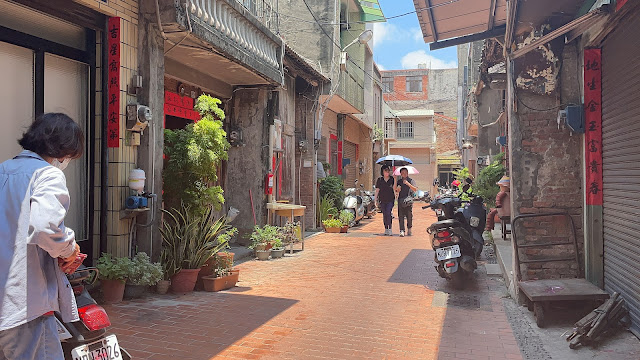










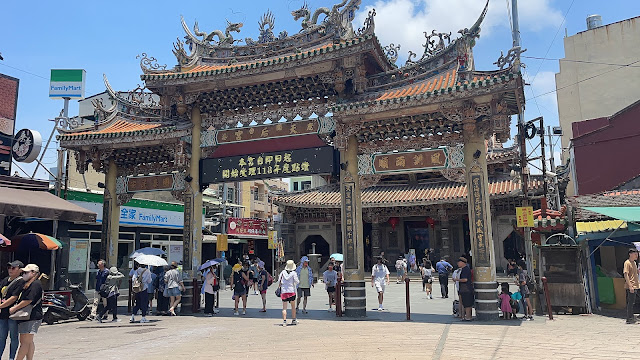









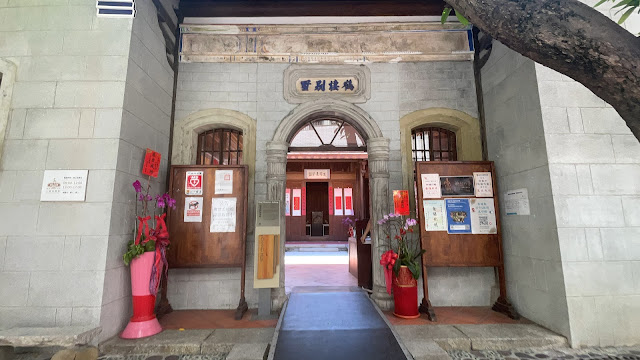


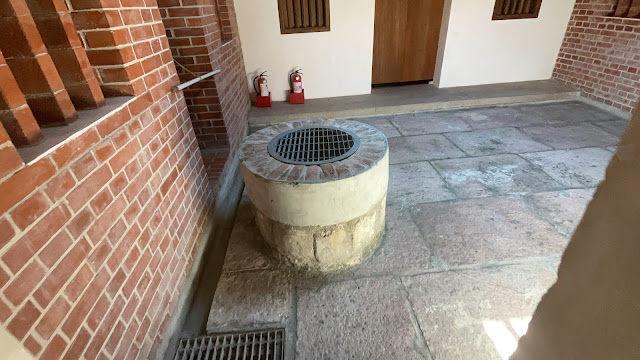
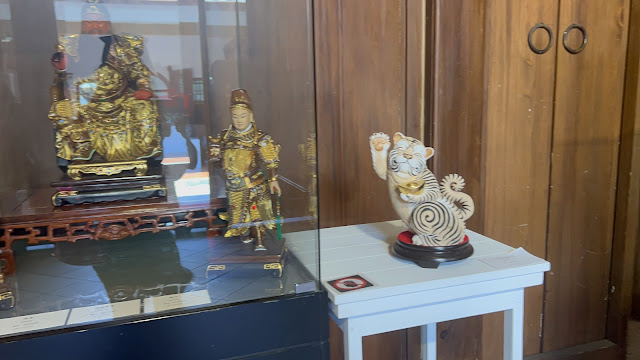









0 komentarze:
Post a Comment